英语听说课试讲模板
- 格式:doc
- 大小:36.50 KB
- 文档页数:2
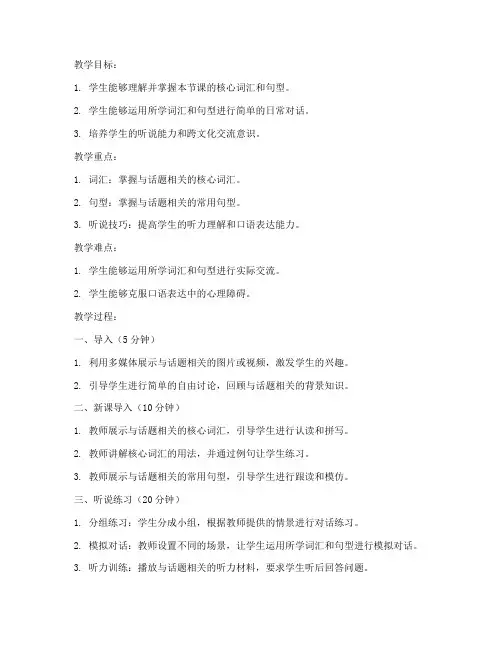
教学目标:1. 学生能够理解并掌握本节课的核心词汇和句型。
2. 学生能够运用所学词汇和句型进行简单的日常对话。
3. 培养学生的听说能力和跨文化交流意识。
教学重点:1. 词汇:掌握与话题相关的核心词汇。
2. 句型:掌握与话题相关的常用句型。
3. 听说技巧:提高学生的听力理解和口语表达能力。
教学难点:1. 学生能够运用所学词汇和句型进行实际交流。
2. 学生能够克服口语表达中的心理障碍。
教学过程:一、导入(5分钟)1. 利用多媒体展示与话题相关的图片或视频,激发学生的兴趣。
2. 引导学生进行简单的自由讨论,回顾与话题相关的背景知识。
二、新课导入(10分钟)1. 教师展示与话题相关的核心词汇,引导学生进行认读和拼写。
2. 教师讲解核心词汇的用法,并通过例句让学生练习。
3. 教师展示与话题相关的常用句型,引导学生进行跟读和模仿。
三、听说练习(20分钟)1. 分组练习:学生分成小组,根据教师提供的情景进行对话练习。
2. 模拟对话:教师设置不同的场景,让学生运用所学词汇和句型进行模拟对话。
3. 听力训练:播放与话题相关的听力材料,要求学生听后回答问题。
四、课堂展示(10分钟)1. 学生分组进行对话展示,教师进行点评和指导。
2. 邀请个别学生进行口语表达展示,教师进行点评和鼓励。
五、总结与作业(5分钟)1. 教师对本节课所学内容进行总结,强调重点和难点。
2. 布置课后作业,要求学生运用所学知识进行听说练习。
教学反思:1. 教师在课堂上应注重激发学生的学习兴趣,提高学生的参与度。
2. 教师应关注学生的个体差异,因材施教,使每个学生都能在课堂上有所收获。
3. 教师应注重培养学生的听说技巧,提高学生的口语表达能力。
4. 教师应关注学生的心理需求,帮助学生克服口语表达中的心理障碍。
教学资源:1. 课件:与话题相关的图片、视频、听力材料等。
2. 词汇卡片:用于展示和练习核心词汇。
3. 话题情景图:用于模拟对话和听力训练。
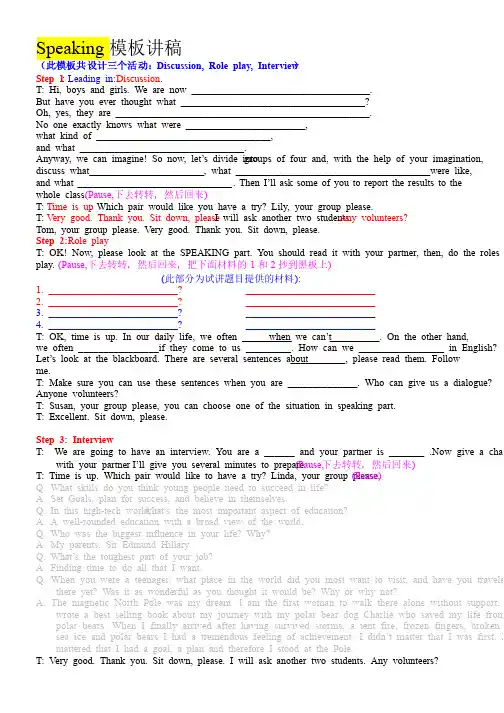
Speaking 模板讲稿(此模板共设计三个活动:Discussion, Role play, Interview ) Step 1: Leading in: D iscussion Discussion . T: Hi, boys and girls. We are now ____________________________________. But have you ever thought what _____________________________________? Oh, yes, they are ___________________________________________________. No one exactly knows what were ________________________, what kind of ___________________________________, and what _________________________________. Anyway, we can imagine! So now, let’s divide into groups of four and, with the help of your imagination, discuss what_______________________, what _______________________________________were like, and and what what what _____________________________________________________________________________________________. . . Then Then Then I’ll I’ll I’ll ask ask ask some some some of of of you you you to to to report report report the the the results results results to to to the the whole class.(Pause,(Pause,下去转转,然后回来) T: Time is up . Which pair would like you have a try? Lily, your group please. . Which pair would like you have a try? Lily, your group please. T: Very good. Thank you. Sit down, please . I will ask another two students. Any volunteers? Tom, your group please. Very good. Thank you. Sit down, please. Step 2: R ole play Role play T: OK! Now, please look at the SPEAKING part. You should read it with your partner, then, do the roles play. (Pause,下去转转,然后回来,把下面材料的1和2抄到黑板上)(此部分为试讲题目提供的材料): 1. __________________________? __________________________ 2. __________________________? __________________________ 3. __________________________? __________________________ 4. __________________________? __________________________ T: OK, time is up. In our daily life, we often __________ when we can’t __________. On the other hand, we often ________________if they come to us _________. How can we _________________ in English? Let’s look at the blackboard. There are several sentences about ___________, please read them. Follow me. T: Make sure you can use these sentences when you are ______________. Who can give us a dialogue? Anyone volunteers? T: Susan, your group please, you can choose one of the situation in speaking part. T: Excellent. Sit down, please. Step 3: Interview T: We are going to have an interview. You are a ______ and your partner is _______ .Now give a cha with your partner . I’ll give you several minutes to prepare. (Pause,下去转转,然后回来下去转转,然后回来)T: Time is up. Which pair would like to have a try? Linda, your group please. (Pause)Q. What skills do you think young people need to succeed in life? A. Set Goals, plan for success, and believe in themselves. Q. In this high-tech world, what’s the most important aspect of education? A. A well-rounded education with a broad view of the world. Q. Who was the biggest influence in your life? Why? A. My parents, Sir Edmund Hillary Q. What’s the toughest part of your job? A. Finding time to do all that I want. Q. When you were a teenager, what place in the world did you most want to visit, and have you travele there yet? Was it as wonderful as you thought it would be? Why or why not? A. The magnetic North Pole was my dream. I am the first woman to walk there alone without support. wrote a best selling book about my journey with my polar bear dog Charlie who saved my life from polar bears. When I finally arrived after having survived storms, a tent fire, frozen fingers, broken sea ice and polar bears I had a tremendous feeling of achievement. I didn’t matter that I was first. I mattered that I had a goal, a plan and therefore I stood at the Pole. T: Very good. Thank you. Sit down, please. I will ask another two students. Any volunteers? Lily, your group please. (Pause)…Blackboard design: Speaking DiscussionStep 1 D iscussionRole play Step 2: R ole play 1. __________________________? __________________________ 2. __________________________? __________________________ Step 3: Interview。
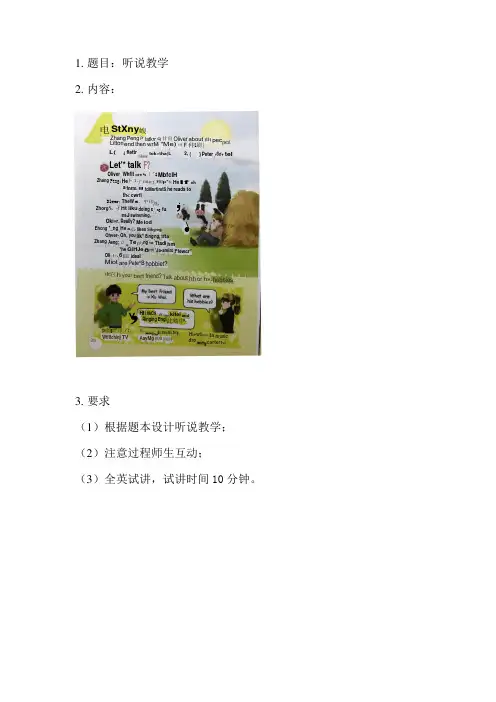
1.题目:听说教学2.内容:3.要求(1)根据题本设计听说教学;(2)注意过程师生互动;(3)全英试讲,试讲时间10分钟。
电StXny 蝮Zhang Peng i>latkrr q 甘出Oliver about 曲pec Litton end then wrM "Me)可F 仲1刷」L (J ftettr tok«tha|L 2,(}Peter »®rf+telp 幽F 甲>巾欧EftiESj Hi+wii 呻ta musicdro carter hi卸Wfflfchinj TV AayMg 咖网时V Hfi likC9kitei and ,Ringing Engl 此劾中s_mJ swimming,'Oki«r.Really?Me lod \Ehcng *_ng He a 心likes Sihgrng •Ohver-Qh,you lik*Bi ng ng,tfta Zhang Aeng;立Te 的ng to Ttadi hm *he GiHJe 8噌'Ja-smirc Ffewcr”Oli 士.6皿idealMiot are Pete^B hobbiet?Let'*talk F?Oliver Whflt ore %「"$MbfciH Zhang Ptng:He 卜工「皿叮y 帽p*航He If oha fnrm.g fcMnrtimtS he reads to th<cwrflDlwer:TheW m、中印地...Zhorg %。
孑Ht liku doing K」ng fu,蛇h your bert friend?Talk about hh or h».-工工F T YF hobbies.教案:I have a pen pal1. Teaching aims1) Knowledge aimStudents will be able to master the sentence patterns: What are his/her hobbies? He/She likes....2) Ability aimStudents are able to master the usage of the sentences patterns and describe their hobbies in real situation.3) Emotional aimStudents can realize“Happiness is the man who is living by his hobby.”2. Important and difficult points1) Important pointStudents will be guided to use the sentence patterns.2) Difficult pointStudents should pay more attention to the understanding of the phrase “Jasmine Flower” and describe someone’s hobbies briefly.3. Teaching and learning methodsSituational teaching method;communicative teaching method; task-based teaching method;group work method;cooperation study method; independent study method4. Teaching proceduresStep 1: Warming upTeacher will sing a song to attract their attention and arouse their enthusiasm---<My new pen pal>: My new pen pal, my new pen pal, he likes to sing, he can sing so loud. My new pen pal, my new pen pal, he likes to play, he can play ping-pong.Step 2: Lead in & PresentationShow pictures of hobbies. Let students guess what are my hobbies? Then lead to today’s topic and break through the difficult point--- Jasmine Flower.Let students listen to the tape and finish “Let’s try” part.Let students listen to the tape of“Let’s talk”part and answer the following two questions:Q1: What are Peter’s hobbies?Q2: Which song will Zhang Peng teach?Step 3: Practice1)Role-play. One can be Zhang Peng. One can be Oliver. Then show in front of the class.2)Pair-work. Ask and answer by using the sentence patterns:What are his/her hobbies? He/She likes....Step 4: ProductionGroup work---Do a survey.Students need to interview their bestfriend in their class and form a new passage to introduce him/her.5 minutes will be given to students. Then show in front of the class.Step 5: Summary and homeworkTeacher leads students to summarize what they have learned in this class.Homework: Introduce your pen pal to your parents & share with us next class.5. Blackboard designI have a pen pal---What are his/her hobbies?“Jasmine Flower”---He/She likes….试讲稿:听说教学I have a pen pal1.Warming upHi,my dear children.Happy to see you again.It’s a beautiful sunshine day.Now let’s begin our class.First,Let’s listen to a song of Zhang Peng: <My new pen pal>: My new pen pal. My new pen pal. He likes to sing. He can sing so loud. My new pen pal. My new pen pal. He likes to play. He plays ping-pong. It’s very beautiful, right? What is this song about? Yes, it’s about Zhang Peng’s new pen pal. Now I will divide。
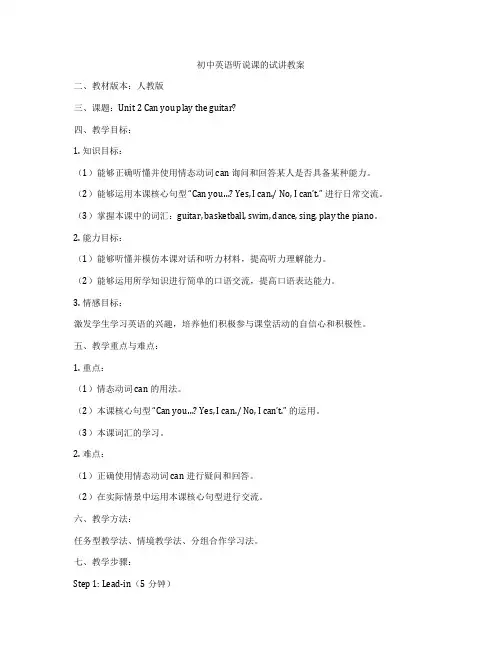
初中英语听说课的试讲教案二、教材版本:人教版三、课题:Unit 2 Can you play the guitar?四、教学目标:1. 知识目标:(1)能够正确听懂并使用情态动词 can 询问和回答某人是否具备某种能力。
(2)能够运用本课核心句型“Can you…? Yes, I can./ No, I can’t.” 进行日常交流。
(3)掌握本课中的词汇:guitar, basketball, swim, dance, sing, play the piano。
2. 能力目标:(1)能够听懂并模仿本课对话和听力材料,提高听力理解能力。
(2)能够运用所学知识进行简单的口语交流,提高口语表达能力。
3. 情感目标:激发学生学习英语的兴趣,培养他们积极参与课堂活动的自信心和积极性。
五、教学重点与难点:1. 重点:(1)情态动词 can 的用法。
(2)本课核心句型“Can you…? Yes, I can./ No, I can’t.” 的运用。
(3)本课词汇的学习。
2. 难点:(1)正确使用情态动词 can 进行疑问和回答。
(2)在实际情景中运用本课核心句型进行交流。
六、教学方法:任务型教学法、情境教学法、分组合作学习法。
七、教学步骤:Step 1: Lead-in(5分钟)1. 教师与学生用中文进行简单的自我介绍,包括自己的姓名、年龄、爱好等。
2. 引导学生用中文讨论自己的同学,询问他们是否具备某些特长或技能,如:“你能唱歌吗?”“你会跳舞吗?”等。
Step 2: Presentation(10分钟)1. 教师展示本课课题“Can you play the guitar?”,引导学生猜测课题内容。
2. 教师通过图片和实物展示本课词汇:guitar, basketball, swim, dance, sing, play the piano。
3. 教师展示本课核心句型“Can you…? Yes, I can./ No, I can’t.”,并进行示范。
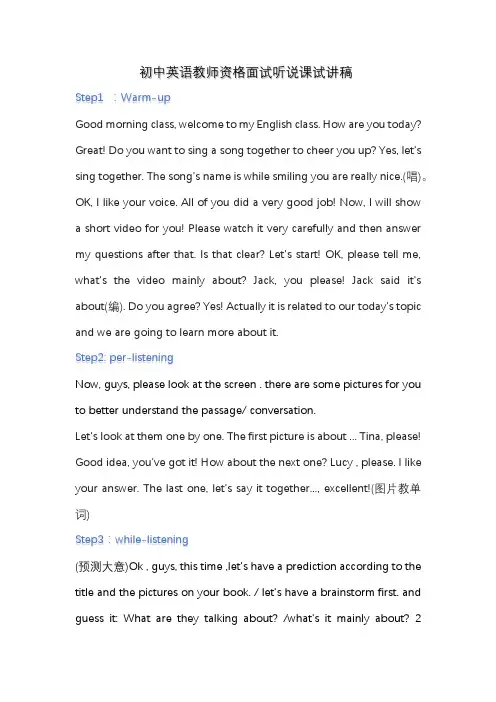
初中英语教师资格面试听说课试讲稿Step1 :Warm-upGood morning class, welcome to my English class. How are you today? Great! Do you want to sing a song together to cheer you up? Yes, let's sing together. The song's name is while smiling you are really nice.(唱)。
OK, I like your voice. All of you did a very good job! Now, I will show a short video for you! Please watch it very carefully and then answer my questions after that. Is that clear? Let's start! OK, please tell me, what's the video mainly about? Jack, you please! Jack said it's about(编). Do you agree? Yes! Actually it is related to our today's topic and we are going to learn more about it.Step2: per-listeningNow, guys, please look at the screen . there are some pictures for you to better understand the passage/ conversation.Let's look at them one by one. The first picture is about ... Tina, please! Good idea, you've got it! How about the next one? Lucy , please. I like your answer. The last one, let's say it together..., excellent!(图片教单词)Step3:while-listening(预测大意)Ok , guys, this time ,let’s have a prediction according to the title and the pictures on your book. / let's have a brainstorm first. and guess it: What are they talking about? /what's it mainly about? 2minutes for you. (停顿)。
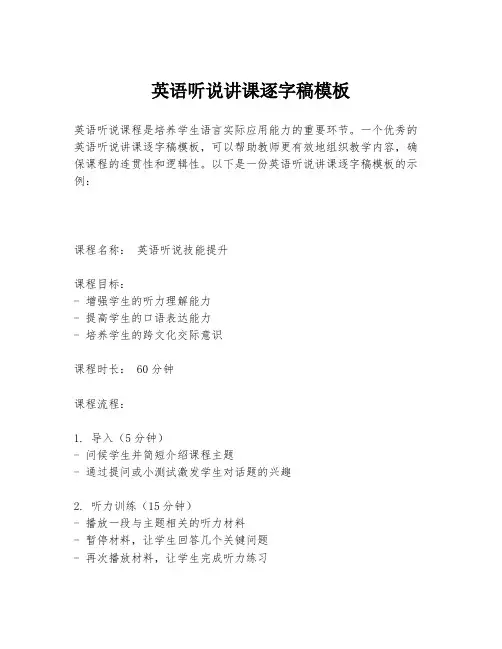
英语听说讲课逐字稿模板英语听说课程是培养学生语言实际应用能力的重要环节。
一个优秀的英语听说讲课逐字稿模板,可以帮助教师更有效地组织教学内容,确保课程的连贯性和逻辑性。
以下是一份英语听说讲课逐字稿模板的示例:课程名称:英语听说技能提升课程目标:- 增强学生的听力理解能力- 提高学生的口语表达能力- 培养学生的跨文化交际意识课程时长: 60分钟课程流程:1. 导入(5分钟)- 问候学生并简短介绍课程主题- 通过提问或小测试激发学生对话题的兴趣2. 听力训练(15分钟)- 播放一段与主题相关的听力材料- 暂停材料,让学生回答几个关键问题- 再次播放材料,让学生完成听力练习3. 听力解析(10分钟)- 讨论听力材料中的难点和易错点- 引导学生总结听力技巧和策略4. 口语练习(15分钟)- 分组让学生就听力材料内容进行讨论- 每组选择一名代表进行汇报- 教师给予反馈和指导5. 角色扮演(10分钟)- 根据听力材料设计一个场景,让学生进行角色扮演- 鼓励学生使用新学的词汇和表达6. 口语表达(5分钟)- 学生个人进行口语表达练习,描述自己的经历或观点- 教师提供即时反馈7. 总结与作业布置(10分钟)- 总结本节课的重点和难点- 布置相关的听说作业,如听写练习或口语录音课程结束语:- 鼓励学生在课后继续练习听说技能- 提醒学生注意作业的提交时间和要求此模板可以根据具体的教学内容和学生需求进行调整。
教师在使用时,应注重课程的互动性和实践性,确保学生能够在轻松愉快的氛围中提高英语听说能力。
同时,教师还应根据学生的反馈不断优化教学方法,以达到最佳的教学效果。
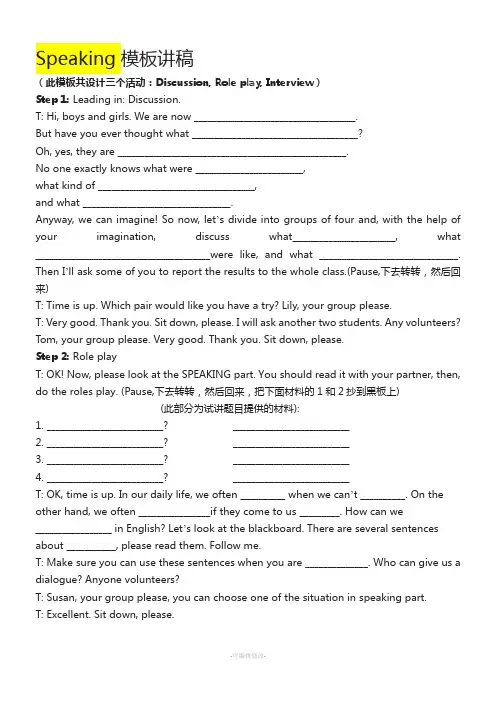
Speaking模板讲稿(此模板共设计三个活动:Discussion, Role play, Interview)Step 1: Leading in: Discussion.T: Hi, boys and girls. We are now ____________________________________.But have you ever thought what _____________________________________?Oh, yes, they are ___________________________________________________.No one exactly knows what were ________________________,what kind of ___________________________________,and what _________________________________.Anyway, we can imagine! So now, let’s divide into groups of four and, with the help of your imagination, discuss what_______________________, what _______________________________________were like, and what _______________________________. Then I’ll ask some of you to report the results to the whole class.(Pause,下去转转,然后回来)T: Time is up. Which pair would like you have a try? Lily, your group please.T: Very good. Thank you. Sit down, please. I will ask another two students. Any volunteers? Tom, your group please. Very good. Thank you. Sit down, please.Step 2: Role playT: OK! Now, please look at the SPEAKING part. You should read it with your partner, then, do the roles play. (Pause,下去转转,然后回来,把下面材料的1和2抄到黑板上)(此部分为试讲题目提供的材料):1. __________________________? __________________________2. __________________________? __________________________3. __________________________? __________________________4. __________________________? __________________________T: OK, time is up. In our daily life, we often __________ when we can’t __________. On the other hand, we often ________________if they come to us _________. How can we_________________ in English? Let’s look at the blackboard. There are several sentences about ___________, please read them. Follow me.T: Make sure you can use these sentences when you are ______________. Who can give us a dialogue? Anyone volunteers?T: Susan, your group please, you can choose one of the situation in speaking part.T: Excellent. Sit down, please.Step 3: InterviewT: We are going to have an interview. You are a ______ and your partner is _______ .Now give a chat with your partner. I’ll give you several minutes to prepare. (Pause,下去转转,然后回来)T: Time is up. Which pair would like to have a try? Linda, your group please. (Pause) Q. What skills do you think young people need to succeed in life?A. Set Goals, plan for success, and believe in themselves.Q. In this high-tech world, what’s the most important aspect of education?A. A well-rounded education with a broad view of the world.Q. Who was the biggest influence in your life? Why?A. My parents, Sir Edmund HillaryQ. What’s the toughest part of your job?A. Finding time to do all that I want.Q. When you were a teenager, what place in the world did you most want to visit, and have you traveled there yet? Was it as wonderful as you thought it would be? Why or why not?A. The magnetic North Pole was my dream. I am the first woman to walk there alonewithout support. I wrote a best selling book about my journey with my polar bear dog Charlie who saved my life from polar bears. When I finally arrived after having survived storms, a tent fire, frozen fingers, broken sea ice and polar bears I had a tremendous feeling of achievement. I didn’t matter that I was first. It mattered that I had a goal, a plan and therefore I stood at the Pole.T: Very good. Thank you. Sit down, please. I will ask another two students. Any volunteers? Lily, your group please. (Pause) …Blackboard design:THANKS !!!致力为企业和个人提供合同协议,策划案计划书,学习课件等等打造全网一站式需求欢迎您的下载,资料仅供参考。
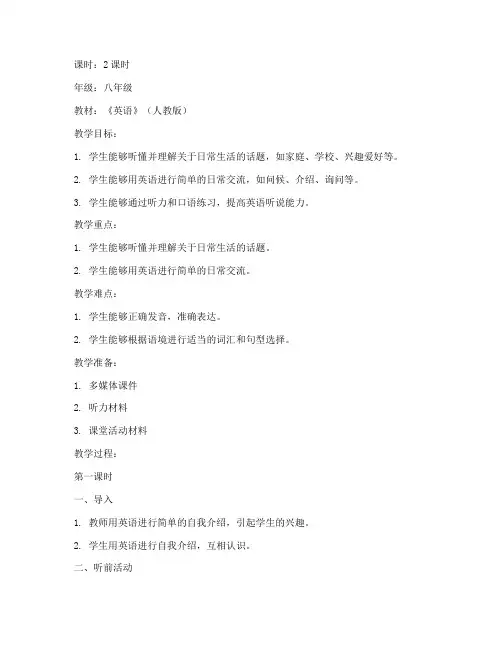
课时:2课时年级:八年级教材:《英语》(人教版)教学目标:1. 学生能够听懂并理解关于日常生活的话题,如家庭、学校、兴趣爱好等。
2. 学生能够用英语进行简单的日常交流,如问候、介绍、询问等。
3. 学生能够通过听力和口语练习,提高英语听说能力。
教学重点:1. 学生能够听懂并理解关于日常生活的话题。
2. 学生能够用英语进行简单的日常交流。
教学难点:1. 学生能够正确发音,准确表达。
2. 学生能够根据语境进行适当的词汇和句型选择。
教学准备:1. 多媒体课件2. 听力材料3. 课堂活动材料教学过程:第一课时一、导入1. 教师用英语进行简单的自我介绍,引起学生的兴趣。
2. 学生用英语进行自我介绍,互相认识。
二、听前活动1. 教师简要介绍听力材料的内容,让学生对即将听到的内容有所了解。
2. 学生根据教师提供的图片或文字,预测听力材料的内容。
三、听力练习1. 学生独立完成听力练习,教师播放听力材料。
2. 学生回答问题,教师点评并纠正错误。
四、口语练习1. 学生根据听力材料的内容,用英语进行简单的口语表达。
2. 教师组织学生进行小组讨论,分享自己的观点。
五、总结与作业1. 教师总结本节课的学习内容,强调重点和难点。
2. 布置课后作业,要求学生复习所学内容。
第二课时一、复习导入1. 教师组织学生复习上一节课的学习内容,巩固所学知识。
2. 学生用英语进行简单的口语表达,展示自己的学习成果。
二、听前活动1. 教师简要介绍听力材料的内容,让学生对即将听到的内容有所了解。
2. 学生根据教师提供的图片或文字,预测听力材料的内容。
三、听力练习1. 学生独立完成听力练习,教师播放听力材料。
2. 学生回答问题,教师点评并纠正错误。
四、口语练习1. 学生根据听力材料的内容,用英语进行简单的口语表达。
2. 教师组织学生进行角色扮演,模拟实际生活场景。
五、总结与作业1. 教师总结本节课的学习内容,强调重点和难点。
2. 布置课后作业,要求学生复习所学内容,并尝试用英语进行日常交流。
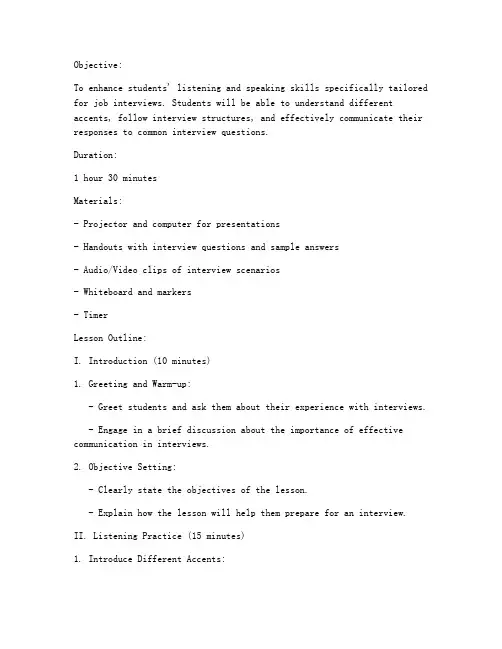
Objective:To enhance students' listening and speaking skills specifically tailored for job interviews. Students will be able to understand different accents, follow interview structures, and effectively communicate their responses to common interview questions.Duration:1 hour 30 minutesMaterials:- Projector and computer for presentations- Handouts with interview questions and sample answers- Audio/Video clips of interview scenarios- Whiteboard and markers- TimerLesson Outline:I. Introduction (10 minutes)1. Greeting and Warm-up:- Greet students and ask them about their experience with interviews.- Engage in a brief discussion about the importance of effective communication in interviews.2. Objective Setting:- Clearly state the objectives of the lesson.- Explain how the lesson will help them prepare for an interview.II. Listening Practice (15 minutes)1. Introduce Different Accents:- Present a short video clip with different accents (British, American, Australian, etc.).- Discuss the importance of understanding different accents and howto adapt listening skills accordingly.2. Listen to Interview Scenarios:- Play a short audio clip of an interview scenario.- Pause after each question and ask students to summarize what they heard.- Discuss the questions and answers as a class.III. Speaking Practice (20 minutes)1. Role-Playing:- Pair students up and assign them roles of interviewee and interviewer.- Provide a list of common interview questions and encourage students to use them during their role-play.2. Group Discussion:- Divide the class into small groups.- Each group discusses and prepares answers to a set of interview questions.- Each group presents their answers to the class.IV. Activity: Creating a Mock Interview (20 minutes)1. Divide the Class:- Split the class into two groups: one group will be the interviewers, and the other will be the interviewees.2. Prepare the Questions:- Provide a list of mock interview questions for the interviewers.3. Conduct the Mock Interviews:- The interviewers ask the questions to the interviewees.- The rest of the class observes and takes notes.4. Feedback Session:- After each mock interview, provide constructive feedback to the interviewees.- Discuss the strengths and areas for improvement.V. Conclusion and Homework (5 minutes)1. Summary:- Recap the main points of the lesson.- Emphasize the importance of practicing listening and speaking skills for interviews.2. Homework Assignment:- Ask students to prepare a short list of their own interview questions and practice answering them.- Encourage them to record their answers and listen back to improve their fluency and pronunciation.Assessment:- Evaluate students' participation in role-plays and group discussions.- Assess their ability to listen and understand different accents.- Monitor their progress in creating and delivering mock interview answers.Note:- Adjust the time allocation for each section based on the class dynamics and student engagement.- Provide additional resources or links to online materials for further practice outside of class.。
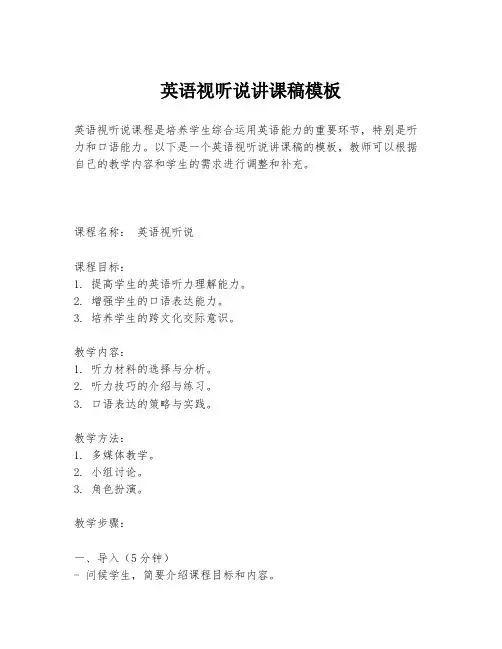
英语视听说讲课稿模板英语视听说课程是培养学生综合运用英语能力的重要环节,特别是听力和口语能力。
以下是一个英语视听说讲课稿的模板,教师可以根据自己的教学内容和学生的需求进行调整和补充。
课程名称:英语视听说课程目标:1. 提高学生的英语听力理解能力。
2. 增强学生的口语表达能力。
3. 培养学生的跨文化交际意识。
教学内容:1. 听力材料的选择与分析。
2. 听力技巧的介绍与练习。
3. 口语表达的策略与实践。
教学方法:1. 多媒体教学。
2. 小组讨论。
3. 角色扮演。
教学步骤:一、导入(5分钟)- 问候学生,简要介绍课程目标和内容。
- 通过一个简单的英语听力练习,激发学生的兴趣。
二、听力材料分析(15分钟)- 播放一段英语听力材料,可以是新闻报道、电影片段或播客。
- 暂停播放,让学生分享他们听到的关键信息。
- 讨论材料的主题、语言特点和文化背景。
三、听力技巧讲解(10分钟)- 介绍几种常见的听力技巧,如预测、关键词捕捉、主旨概括等。
- 通过示例演示这些技巧的应用。
四、听力练习(15分钟)- 分发听力练习材料,让学生独立完成。
- 播放听力材料,学生边听边做笔记。
- 练习结束后,组织学生讨论答案和听力策略。
五、口语表达策略(10分钟)- 讲解口语表达的基本策略,如清晰发音、逻辑组织、有效使用肢体语言等。
- 通过角色扮演或模拟对话,让学生实践这些策略。
六、口语实践(15分钟)- 分组进行口语练习,每组选择一个话题进行讨论。
- 每组选出一名代表,向全班展示他们的讨论结果。
七、跨文化交际意识培养(10分钟)- 讨论听力材料中的文化差异和交际策略。
- 分享跨文化交流中可能遇到的挑战和应对方法。
八、总结与反馈(10分钟)- 总结本节课的主要内容和学习点。
- 收集学生的反馈,了解他们的学习感受和建议。
九、作业布置(5分钟)- 布置相关的听力和口语作业,鼓励学生在课外继续练习。
十、结束语(2分钟)- 鼓励学生积极参与课堂活动,期待他们在下节课的表现。
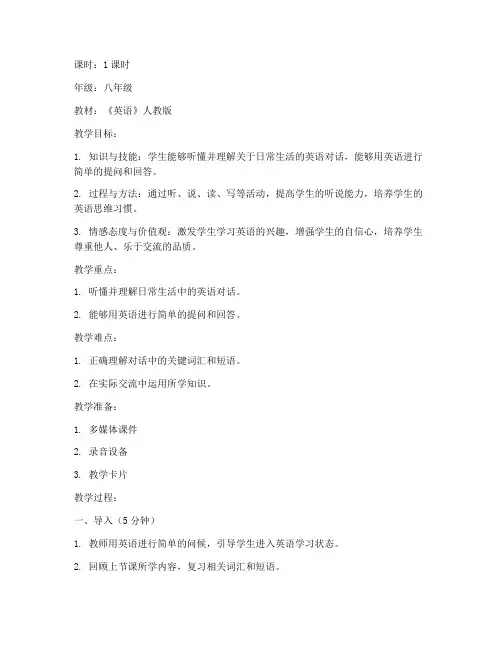
课时:1课时年级:八年级教材:《英语》人教版教学目标:1. 知识与技能:学生能够听懂并理解关于日常生活的英语对话,能够用英语进行简单的提问和回答。
2. 过程与方法:通过听、说、读、写等活动,提高学生的听说能力,培养学生的英语思维习惯。
3. 情感态度与价值观:激发学生学习英语的兴趣,增强学生的自信心,培养学生尊重他人、乐于交流的品质。
教学重点:1. 听懂并理解日常生活中的英语对话。
2. 能够用英语进行简单的提问和回答。
教学难点:1. 正确理解对话中的关键词汇和短语。
2. 在实际交流中运用所学知识。
教学准备:1. 多媒体课件2. 录音设备3. 教学卡片教学过程:一、导入(5分钟)1. 教师用英语进行简单的问候,引导学生进入英语学习状态。
2. 回顾上节课所学内容,复习相关词汇和短语。
二、听力训练(15分钟)1. 播放录音,学生听录音,完成听力练习题。
2. 教师讲解听力练习题的答案,并对学生进行点评。
三、口语练习(20分钟)1. 教师展示教学卡片,展示日常生活中的场景,如购物、问路等。
2. 学生分组进行角色扮演,模拟对话场景。
3. 教师巡视指导,纠正学生的发音和语法错误。
四、小组讨论(10分钟)1. 教师提出问题,如:“How do you usually go to school?”(你通常怎么去学校?)2. 学生分组讨论,用英语表达自己的观点。
3. 每组选派代表进行汇报,其他组进行评价。
五、总结与拓展(5分钟)1. 教师总结本节课所学内容,强调重点和难点。
2. 学生分享学习心得,提出疑问。
3. 教师布置课后作业,如:收集日常生活中常用的英语短语,准备下节课的口语练习。
教学反思:本节课通过听、说、读、写等活动,提高了学生的听说能力。
在教学过程中,要注意以下几点:1. 注重学生的个体差异,关注学生的发音和语法错误,及时给予纠正和指导。
2. 创设真实的语言环境,激发学生的学习兴趣,提高学生的英语思维能力。
一、课程名称:英语听说课二、课时:1课时三、教学目标:1. 知识与技能:学生能够掌握本节课的听力材料,并能够准确理解对话内容。
2. 过程与方法:通过听力训练,提高学生的英语听说能力,培养良好的听力习惯。
3. 情感态度与价值观:激发学生对英语学习的兴趣,增强自信心。
四、教学重点与难点:1. 重点:听力材料的理解与掌握。
2. 难点:提高学生的听力技巧,培养学生的口语表达能力。
五、教学准备:1. 教师准备:多媒体课件、听力材料、单词卡片等。
2. 学生准备:笔记本、笔。
六、教学过程:(一)导入1. 教师用英语进行简短的自我介绍,让学生了解教师的基本情况。
2. 提问:What's your name? How old are you? Are you a student? 等问题,让学生用英语回答。
(二)新授1. 教师播放听力材料,让学生听第一遍,要求学生尽可能多地获取信息。
2. 教师提问:What did you hear? 让学生回答,并检查学生的听力理解情况。
3. 教师播放听力材料第二遍,让学生注意听力技巧,如:关键词、句子结构等。
4. 教师讲解听力材料中的重点词汇和短语,并进行讲解和示范。
(三)练习1. 学生分小组进行听力练习,教师巡回指导。
2. 学生用所学词汇和短语进行对话练习,教师给予点评和指导。
(四)巩固1. 教师组织学生进行听力游戏,如:听音辨词、听音选图等,提高学生的听力兴趣。
2. 学生用所学词汇和短语进行口语表达,教师给予点评和指导。
(五)小结1. 教师总结本节课的学习内容,强调听力技巧和口语表达的重要性。
2. 学生分享学习心得,教师给予肯定和鼓励。
七、作业布置:1. 学生回家后,听英语听力材料,并记录下重点词汇和短语。
2. 学生用所学词汇和短语进行口语表达,与家人或朋友进行对话练习。
八、板书设计:1. 课题:英语听说课2. 重点词汇和短语:What did you hear? How old are you? Are you a student? 等3. 听力技巧:关键词、句子结构等九、教学反思:本节课通过听力材料和口语练习,提高了学生的英语听说能力。
初中英语试讲听说课稿子同学们,今天我们要进行一节初中英语的听说课。
这节课的主题是“日常生活”,我们将通过听和说的练习来提高我们的英语听力和口语能力。
首先,让我们来听一段对话。
这段对话发生在一家餐厅,两位朋友正在讨论他们的食物和饮料。
请大家仔细听,注意他们使用的词汇和句型。
[播放对话录音]现在,我们已经听过了这段对话。
接下来,请大家尝试回答以下几个问题:1. 他们点了什么食物?2. 他们点了什么饮料?3. 他们对食物和服务有什么评价?[等待学生回答]很好,现在让我们来练习一下口语。
我们将分成小组,每组模拟在餐厅点餐的场景。
每组需要选出一位服务员和一位顾客。
服务员需要询问顾客想要点什么,并给出一些建议。
顾客则需要表达自己的需求和偏好。
[学生分组练习]在练习过程中,请大家注意以下几点:- 使用正确的时态和语态。
- 注意使用礼貌用语,如“Could I have...”或“Would you like...”。
- 尝试使用不同的句型和词汇来表达相同的意思。
[学生练习结束后]现在,让我们来总结一下今天学到的内容。
我们学习了如何在餐厅点餐,包括询问和提供信息的句型。
我们还练习了听力,通过听一段对话来理解对话内容。
希望你们能够将今天学到的知识应用到实际生活中。
最后,给大家布置一个小任务:回家后,尝试和家人或朋友用英语进行一次点餐的对话,并记录下来。
下次课上,我们可以分享我们的对话。
这节课就到这里,希望大家都能够有所收获。
下课!。
高中英语听力试讲逐字稿尊敬的各位老师,大家好!今天我要分享的是高中英语听力教学。
听力是英语学习中非常重要的一部分,但往往也是学生觉得最难掌握的技能之一。
因此,如何有效地进行听力教学,提高学生的听力水平,是摆在我们面前的一个重要课题。
首先,我们要明确听力教学的目标。
我们的目标是帮助学生掌握听力技巧,提高听力理解能力,同时培养他们的跨文化交际意识和能力。
为了实现这一目标,我们需要从以下几个方面展开教学。
一、激活学生的背景知识在进行听力教学时,激活学生的背景知识至关重要。
背景知识不仅包括学科知识,还包括学生的生活经验和文化背景。
例如,在听一篇关于西方文化的文章时,如果学生不了解相关的文化背景,他们就会感到困惑和难以理解。
因此,我们需要通过引导学生讨论相关话题、分享经验等方式,激活他们的背景知识,帮助他们更好地理解听力材料。
二、提高学生的词汇量词汇量是影响学生听力理解能力的重要因素之一。
因此,提高学生的词汇量是听力教学的关键环节。
我们可以引导学生通过上下文猜测词义、教授构词法等方式来增加他们的词汇量。
同时,我们还需要教授学生一些实用的听力技巧,如预测答案、筛选无关信息等。
三、创造良好的听力环境良好的听力环境是提高学生听力水平的重要保障。
我们可以通过组织英语角、邀请外教参加教学活动等方式,为学生创造真实的语言环境。
同时,我们还可以利用现代技术手段,如语音识别软件等,为学生提供更多的听力练习机会。
四、培养学生的跨文化交际意识培养学生的跨文化交际意识是听力教学的重要目标之一。
我们可以通过引导学生了解不同文化背景下的语言表达方式、礼仪习俗等方式,培养他们的跨文化交际意识。
同时,我们还需要教授学生一些实用的交际技巧,如如何与人交流、如何表达自己的观点等。
总之,高中英语听力教学需要从多个方面入手,注重培养学生的实际运用能力。
只有这样,才能真正提高学生的听力水平,为他们的未来发展奠定坚实的基础。
谢谢大家!。
教学目标:1. 通过听读,学生能够理解并掌握课文的主要内容。
2. 培养学生的英语听力和阅读能力,提高学生的语言运用能力。
3. 培养学生的合作意识,提高学生的口语表达能力。
教学重点:1. 听懂课文内容,理解课文大意。
2. 词汇和句型的积累与运用。
教学难点:1. 学生对课文的听力和理解能力。
2. 学生在口语表达中运用所学词汇和句型。
教学准备:1. 教师准备课文录音、PPT、单词卡片等教学材料。
2. 学生准备课文的预习和笔记。
教学过程:一、导入1. 用简短的英语问候学生,激发学生的学习兴趣。
2. 引导学生回顾上节课的内容,复习所学词汇和句型。
二、听读课文1. 学生听课文录音,要求跟读,注意语音、语调。
2. 教师播放课文录音,学生跟读,教师巡视指导。
3. 学生自主阅读课文,要求理解课文大意,注意生词和难句。
三、课堂活动1. 教师提问,检查学生对课文内容的理解。
2. 学生分组讨论,分享自己对课文的理解和感受。
3. 学生上台表演课文,锻炼口语表达能力。
四、词汇和句型讲解1. 教师讲解课文中的重点词汇和句型,要求学生跟读。
2. 学生进行词汇和句型的练习,教师巡视指导。
五、课堂小结1. 教师总结本节课所学内容,强调重点词汇和句型。
2. 学生回顾所学内容,分享自己的学习心得。
六、布置作业1. 复习课文,巩固所学词汇和句型。
2. 完成课后练习题,提高阅读能力。
教学反思:1. 教师在课堂教学中要关注学生的个体差异,针对不同层次的学生进行辅导。
2. 在听读过程中,教师要引导学生注意语音、语调,提高学生的听力和口语表达能力。
3. 课堂活动要充分调动学生的积极性,培养学生的合作意识。
4. 教师要及时总结教学过程中的问题,不断改进教学方法,提高教学质量。
听说课逐字稿模版warming upClass begins,good morning,boys and girls!How are you today?Great?So glad to hear that!Before our class,let’s play a guessing game.ready?OK。
Listen to me carefully.What's the smallest room in the world?Mushroom!Wonderful!you are so smart。
lead inAt the beginning of the class,I'd like to show you a video,Please look at the screen(手指ppt)......It's interesting right?Now,Who can tell me what's the video talking about(环顾四周).Vinsa,please.Yes,very good,thank you,sit down please.(请坐的姿势)The video is talking about xxx(视频内容,备课时设计好)Today,we will learn a new lesson about this—标题(若无标题:Today,we will listen to a new dialogue about this.)pre—listening预测Before listening,let’s have a prediction according to the title.Discuss with your deskmate:what may tell in the conversation?(停顿)/What a heated discussion!/ Who would like to share your answers?Robert,please./Robert said i(t might talk about someone who likes music.)Good guess./We’ll see whether your prediction is right.讲单词To help us understand the passage better,let’s go through the new words first. Please look at the blackboard.(板书)/The first one is join.What’s the meaning of this word?Well,it means being a member of.If you join a basketball club,you are a member of the basketball club.Clear?/Ok,you are so smart.The next one is chess. Do you know chess?No?Please look at the ppt.Yes,this is chess.Who can play chess? Wow,so many of you can play it.It’s impressive.(讲解句型,有些不用讲,讲解材料里有的句型)In order to understand the conversation better,I want to show you a new sentence pattern.Please look at the blackboard.(板书)When you want to know your friend plays the guitar or not,you can say“Can you play the guitar?”Then your friend will answer you like this“Yes,I can”or“No,I can’t”.Clear?Good,you are so clever.)while—listening第一遍听:处理大意Now,please listen to the tape(me)for the first time and try to get the general idea of the conversation/passage,I will ask someone to share your answers.(please listen carefully.结束之后Ok Who can...)Here we go.(停顿)/OK,stop here./Who can tell me the main idea?Kevin please!/Do you agree with him?Yes,I。
Speaking模板讲稿
(此模板共设计三个活动:Discussion, Role play, Interview)
Step 1: Leading in: Discussion.
T: Hi, boys and girls. We are now ____________________________________.
But have you ever thought what _____________________________________?
Oh, yes, they are ___________________________________________________.
No one exactly knows what were ________________________,
what kind of ___________________________________,
and what _________________________________.
Anyway, we can imagine! So now, let’s divide into groups of four and, with the help of your imagination, discuss what_______________________, what _______________________________________were like, and what _______________________________. Then I’ll ask some of you to report the results to the whole class.(Pause,下去转转,然后回来)
T: Time is up. Which pair would like you have a try? Lily, your group please.
T: Very good. Thank you. Sit down, please. I will ask another two students. Any volunteers?
Tom, your group please. Very good. Thank you. Sit down, please.
Step 2: Role play
T: OK! Now, please look at the SPEAKING part. You should read it with your partner, then, do the roles play. (Pause,下去转转,然后回来,把下面材料的1和2抄到黑板上)
(此部分为试讲题目提供的材料):
1. __________________________? __________________________
2. __________________________? __________________________
3. __________________________? __________________________
4. __________________________? __________________________
T: OK, time is up. In our daily life, we often __________ when we can’t __________. On the other hand, we often ________________if they come to us _________. How can we _________________ in English? Let’s look at the blackboard. There are several sentences about ___________, please read them. Follow me.
T: Make sure you can use these sentences when you are ______________. Who can give us a dialogue? Anyone volunteers?
T: Susan, your group please, you can choose one of the situation in speaking part.
T: Excellent. Sit down, please.
Step 3: Interview
T: We are going to have an interview. You are a ______ and your partner is _______ .Now give a chat with your partner. I’ll give you several minutes to prepare. (Pause,下去转转,然后回来)
T: Time is up. Which pair would like to have a try? Linda, your group please. (Pause)
Q. What skills do you think young people need to succeed in life?
A. Set Goals, plan for success, and believe in themselves.
Q. In this high-tech world, what’s the most important aspect of education?
A. A well-rounded education with a broad view of the world.
Q. Who was the biggest influence in your life? Why?
A. My parents, Sir Edmund Hillary
Q. What’s the toughest part of your job?
A. Finding time to do all that I want.
Q. When you were a teenager, what place in the world did you most want to visit, and have you traveled there yet? Was it as wonderful as you thought it would be? Why or why not?
A. The magnetic North Pole was my dream. I am the first woman to walk there alone without support. I
wrote a best selling book about my journey with my polar bear dog Charlie who saved my life from polar bears. When I finally arrived after having survived storms, a tent fire, frozen fingers, broken
sea ice and polar bears I had a tremendous feeling of achievement. I didn’t matter that I was first. It mattered that I had a goal, a plan and therefore I stood at the Pole.
T: Very good. Thank you. Sit down, please. I will ask another two students. Any volunteers?
Lily, your group please. (Pause)…
Blackboard design:。